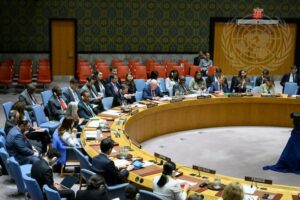Technology
For decades, progress in semiconductors meant miniaturization in line with Moore’s Law. Today, with the industry’s revenue expected to reach one trillion dollars by the end of the decade, semiconductor technology is moving beyond Moore’s Law with new technological paradigms and different fields of application. Customization of chips is increasingly important, as are the roles of emerging technologies like AI to be incorporated into many aspects of the production process. With the complex, interdependent supply chain stretching across multiple regions, it seems nearly impossible for a single country to orchestrate a self-sufficient semiconductor supply chain. The future of the industry will be based on innovations other than miniaturization, and a key element of this will be ensuring the talent pipeline – from design to manufacturing – is robust. Universities can play a unique role in bringing together private sector needs, public interests, and academic expertise to train students in acquiring creative, technical, and problem-solving skills needed in the semiconductor industry. The U.S. leads in the design area and can use this expertise to retain its leadership in semiconductor technology, whereas Taiwan is the frontrunner in manufacturing.
Yet the importance of semiconductors for national security purposes has raised the concept of “chip war,” with the United States imposing export controls on the industry. This may result in China being forced to find ways around the supply chain that it cannot access, funding more domestic R&D and manufacturing activities, and making tradeoff decisions about when Chinese companies can use mature chip technology in place of the cutting-edge tech in the U.S. supply chain. As an alternative vision to the competitive semiconductor landscape, the concept of “chip peace” should be promoted, focusing on the application of chips to improve standards of living and global economic welfare by emphasizing civilian usage and collaborative applications. Only civilian applications can ensure sufficient production quantity to advance the technology. National security needs can build on these quantity-enabled technological advances by adding necessary features. Unfortunately, looking at semiconductors from a confrontational perspective can create an environment of distrust, in which Taiwan, as home to the majority of the chip manufacturing capacity, is caught in the crossfire. To find a way forward for Taiwan and the U.S., building trust through exchange of views will be an essential part of the policy-making process.
Industry
Over the past few decades, the semiconductor industry has been a central source of innovation and led to the rapid growth of a wide spectrum of industries globally. Taiwan is a key player in this industry under modularization with global sourcing and a highly diversified supply chain. Its success is rooted in a unique ecosystem that integrates many small and medium firms along the supply chain with knowledgeable and experienced skilled labor and well-designed and tested organizational capital. Its significant role is supported by a location quotient of 9, more than double of the runner-up, South Korea. Without the establishment of a full semiconductor ecosystem in the U.S., the TSMC-Arizona plant could become a second Intel, which serves little purpose in enhancing supply chain resilience. The development of the industry exhibits strong U.S.-Taiwan interdependence and yields large mutual gains. Being an indispensable partner to the U.S., Taiwan must be included in the U.S.’s friend-shoring chain, whereas diversification should not be over-emphasized as it may cause a hollowing-out of Taiwan’s signature industry.
Wrongdoing is worse than not doing because of the irreversibility of the sunk damage. Historical data show many failed and wasteful industrial policies. With regards to export controls, one must calculate possible, unintended outcomes including speeding up China’s efforts to catch up, triggering retaliations and causing business losses. With regards to chip subsidies, it is well known that one policy cannot achieve many objectives in a complex, dynamic world. As such, allocating large funds in a limited period of time and targeting manufacturing with mass production that has been abandoned for a long time is likely to lead to suboptimal selections and misuse of capital without significant creation of jobs. Cost hikes due to human capital adjustments and reconfiguration may result in huge efficiency losses and economic instability. This is a loss that would harm the U.S., Taiwan, and the world as a whole. While it is important to ensure national security, economic security should not be compromised.
Security & Geopolitics
Recently, the geopolitical risks have been on the rise across the Taiwan Strait. As the hawkish voices become much more vocal on the mainland side, there are also worrying signs in Taiwan. There is a huge perception gap between the U.S. and Taiwan: While the risk perception of military conflicts across the Taiwan Strait has increased dramatically in the former, that held by most civilians in the latter remains at a low level. Most Taiwanese people would like to enjoy cost-free security and have a high expectation of U.S. involvement if China invades. Taiwan’s armed forces have not been thoroughly trained, and Taiwan’s recent recruitment of military volunteers has not been very successful. On the U.S. side, as the security risk across the Pacific goes up amidst global supply chain adjustments, there are a host of challenges inside the U.S. policymaking processes to make a more balanced policy that addresses both security concerns and economic benefits. The challenge of policy coordination often extends to the international level, where it takes hard work and time to align the interests of different nations. As modern digital technology advances and spreads, it further complicates the current geopolitical landscape.
To tackle these new challenges, multifaceted collaborations at the international level are necessary. Based on various hard facts on the ground, it is better to make Taiwan less contentious in great power competition. To achieve this, more cross-strait dialogues are needed to lower tensions, and, as a last resort, a U.S.-China dialogue to stabilize the situation. Moreover, on the U.S.-Taiwan relations side, a win-win strategy for both parties will need deeper interdependence among allies, the U.S., and Taiwan. First, on supply chain adjustments, as the industry moves from “just-in-time” to “just-in-case,” what has been lacking in the discussion is the funding for friend-shoring, and every country is looking for a way to contribute to this endeavor. It is an opportunity for both the U.S. and Taiwan to help. Second, the U.S. and Taiwan should also collaborate on a new model of education with shorter training cycles, as people need to learn newer and more mobile skills at a much faster pace. Third, on the investment side, to create more interdependence between the U.S. and Taiwan, both parties should also work together to bring more new start-up companies to the semiconductor industry and incentivize them to fill the demand gap in the supply chain.
Policy Recommendations
- While it is important to ensure national security, economic security should not be compromised. It should be stressed that the U.S. chip policy is rebalancing rather than establishing self-sufficiency. Thorough evaluation should be made toward better allocating the subsidies and reshaping the global supply chain to reassure both national security and economic security with manageable efficiency losses.
- Taiwan must be included in the U.S. friend-shoring chain, whereas diversification should not be overdone to avoid hollowing out Taiwan’s signature industry. A proactive approach is for the U.S. and Taiwan to work together to ensure chip security and to advance the necessary ingredient of the semiconductor industry – human capital. Investment in the semiconductor industry by nurturing talent and skills in the industry’s people is critical to both future breakthroughs in semiconductor technology and the industry’s current needs.
- To ensure successful outcomes from the joint effort between the U.S. and Taiwan, trust plays a crucial role. Trust can be assured only under the principle of equal footing, mutual benefits, and full communication. The U.S. and Taiwan should expand regular communication on these issues at government, industry, and civil society levels to build trust.




